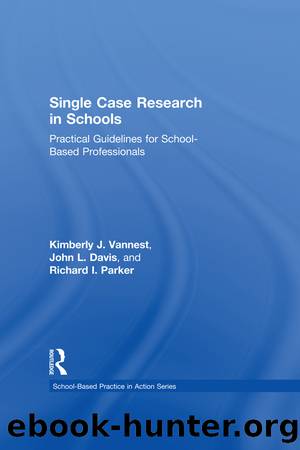Single Case Research in Schools by Vannest Kimberly J.;Davis John L.;Parker Richard I.; & John L. Davis & Richard I. Parker

Author:Vannest, Kimberly J.;Davis, John L.;Parker, Richard I.; & John L. Davis & Richard I. Parker
Language: eng
Format: epub
Publisher: Taylor & Francis Group
Published: 2013-08-15T00:00:00+00:00
Comparing Effects Across Designs
Aggregating study effects across designs follows similar logic to aggregating effect sizes within a design, but this process is much easier due to the fact that selecting which contrasts to aggregate is already taken care of in the within design calculation. Mathematically, the process is identical to the within design process of aggregating effects. The two primary ingredients still are necessary, effect size and the variance from that effect size. Each study effect size will be weighted by the inverse of the variance then summed together and divided by the sum of the weights. See Figure 4.7 below for mathematical formula in question.
Figure 4.7 Formula for weighting effect sizes. This formula only demonstrates the aggregation of two studies. Additional studies can be aggregated simply by adding the weighted the effect size in the numerator and the accompanying weight in the denominator.
Comparing Effects Many times there are variables of interest that one may want to analyze from a particular set of studies. For example one may want to determine if males or females respond better to a particular intervention. Analysis of these variables can follow standard practice for analyzing categorical variables (Agresti, 1996; Siegel & Castellan, 1988). These variables can be coded separately (for example, gender, age, etc), and then sets of effect sizes from studies that contain that particular variable can be compared to determine statistically significant differences. Two variables comparisons (for example, male and female) can be evaluated using the Mann-Whitney U statistic. Three variable comparisons (for example, elementary, middle school, and high school) can be evaluated with the Kruskal-Wallis one-way analysis of variance. Both of these analytic techniques can be found in most commercially available statistical packages.
Download
This site does not store any files on its server. We only index and link to content provided by other sites. Please contact the content providers to delete copyright contents if any and email us, we'll remove relevant links or contents immediately.
Adding Value to Policy Analysis and Advice by Claudia Scott; Karen Baehler(455)
Sociological Perspectives of Health and Illness by Constantinos N. Phellas(444)
Race and American Political Development by unknow(441)
Human and Global Security : An Exploration of Terms by Peter Stoett(425)
American Government and Politics Today by Steffen W. Schmidt Mack C. Shelley Barbara A. Bardes(424)
Control Of Oil - Hardback by Kayal(407)
Entrepreneurship Education and Training: The Issue of Effectiveness by Colette Henry Frances Hill Claire Leitch(364)
The Catholic Church and European State Formation, AD 1000-1500 by Jørgen Møller(355)
Materializing the Middle Passage by Jane Webster;(349)
The World According to China by Elizabeth C. Economy(343)
Left Is Not Woke by Susan Neiman(328)
Turkey's Relations with the West and the Turkic Republics: The Rise and Fall of the Turkish Model by Idris Bal(313)
Theories of Counseling and Psychotherapy: A Case Approach by Nancy L. Murdock(313)
Cross-Cultural Child Development for Social Workers by Lena Robinson(306)
Japan's Ainu Minority in Tokyo by Mark K. Watson(297)
Advances in Child Development and Behavior, Volume 37 by Patricia J. Bauer(295)
Laboratory Life by Bruno Latour(294)
Beyond Service: State Workers, Public Policy, and the Prospects for Democratic Administration by Greg McElligott(284)
The Oxford Handbook of Museum Archaeology by Stevenson Alice;(275)
